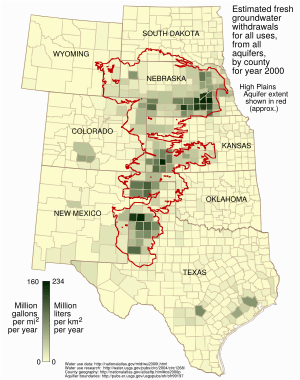List of aquifers in the United States facts for kids

An aquifer is like a giant underground sponge made of rock, sand, or gravel that holds water. This water is called groundwater. When it rains, some water soaks into the ground and fills up these aquifers. People can then drill wells into aquifers to get water for drinking, farming, and other uses.
The United States has many important aquifers. They are a vital source of fresh water for millions of people and for growing crops.
Contents
- Important Aquifers in the United States
- The Ogallala Aquifer: A Giant Underground Lake
- The Floridan Aquifer: Under the Sunshine State
- The Edwards Aquifer: Texas's Water Source
- Basin and Range Carbonate Aquifer: Water in the Desert
- The Snake River Aquifer: Feeding Farmland
- The Kirkwood–Cohansey Aquifer: Pure Water in New Jersey
- The Mahomet Aquifer: Central Illinois's Supply
- Other Important Aquifers
- The Central Valley Basin: California's Farming Lifeline
- See also
Important Aquifers in the United States
The Ogallala Aquifer: A Giant Underground Lake
The Ogallala Aquifer is one of the biggest aquifers in the world. It stretches across eight states in the central United States. Much of the water in this aquifer is "fossil water", which means it's very old, left over from the last Ice Age.
People use a lot of water from the Ogallala Aquifer, especially for farming and cities. Because so much water is being taken out, the aquifer is getting smaller in some places. Only a small amount of new water, about 10% of what's used, goes back into the aquifer each year in drier areas. This makes it important to use this water wisely.
The Floridan Aquifer: Under the Sunshine State
The Floridan Aquifer is huge! It lies beneath all of Florida and parts of Alabama, Georgia, and South Carolina, covering an area of 100,000 square miles (about 260,000 square kilometers). This aquifer formed millions of years ago when Florida was underwater. It's known as one of the world's most productive aquifers, meaning it can provide a lot of water.
The Edwards Aquifer: Texas's Water Source
In Texas, the Edwards Aquifer is a key water source for almost 2 million people. It also feeds many large springs. This aquifer is special because it gets a lot of new water from nearby streams, rivers, and lakes. This means it stays full. However, building too many homes and businesses over the areas where water recharges the aquifer could be a problem in the future.
Basin and Range Carbonate Aquifer: Water in the Desert
This aquifer, known by many names, is found in several western states. Water flows through cracked carbonate rock deep underground. This water then comes to the surface in many regional springs and water features, like those at Fish Springs National Wildlife Refuge and Death Valley. Studying this aquifer helps us understand how water moves in these dry regions.
The Snake River Aquifer: Feeding Farmland
Located in Southern Idaho, the Snake River Aquifer stretches from near Yellowstone National Park to Hell's Canyon. Water from this aquifer is used to water over 3 million acres (about 12,000 square kilometers) of farmland. It also provides drinking water for many towns in Southern Idaho.
The Kirkwood–Cohansey Aquifer: Pure Water in New Jersey
Under the Pine Barrens (New Jersey) in southern New Jersey, you'll find the Kirkwood–Cohansey Aquifer. It holds an amazing 17 trillion US gallons (64 cubic kilometers) of water. This water is some of the purest in the United States.
The Mahomet Aquifer: Central Illinois's Supply
The Mahomet Aquifer provides water for about 800,000 people in central Illinois. It contains roughly four trillion US gallons (15 cubic kilometers) of water. A group called the Mahomet Aquifer Consortium was created to study the aquifer. Their goal is to make sure there's enough water for everyone and to prevent arguments over water use.
Other Important Aquifers
- The San Diego Formation is an aquifer that supplies public water in San Diego County, California and Los Angeles, California.
- The Turlock Basin is located under the San Joaquin River in the San Joaquin Valley of central California. It is one of the largest aquifers in the Western United States.
- Washington state also has many large aquifers. You can see them on this map of Washington's underground water systems.
- The Spokane Valley–Rathdrum Prairie Aquifer covers about 325 square miles (840 square kilometers) in eastern Washington and Idaho. It provides drinking water for around 700,000 people.
The Central Valley Basin: California's Farming Lifeline
The Central Valley Basin of California is where a huge amount of US crops are grown. This aquifer holds a lot of fresh water, even though some parts might be affected by oil activities or be a bit salty.
However, there are big challenges. The ground above the aquifer is sinking because so much water is being pumped out. Also, there's a lot of unregulated drilling for water, and some crops need a lot of water. Long periods of dry weather (droughts) also make things harder. Scientists using satellites like GRACE have shown that a lot of water has been lost. Some of the ground has even compacted, meaning it can't hold as much water as it used to.
See also
- More about aquifers and groundwater
- Groundwater
- Groundwater pollution
- Groundwater recharge
- Groundwater-related subsidence


